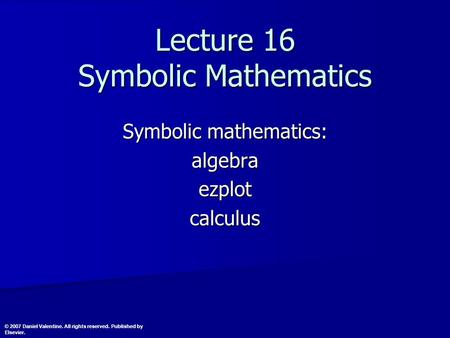

- #RUTGERS SYMBOLIC MATH TOOLBOX FOR FREE#
- #RUTGERS SYMBOLIC MATH TOOLBOX HOW TO#
- #RUTGERS SYMBOLIC MATH TOOLBOX CODE#
- #RUTGERS SYMBOLIC MATH TOOLBOX DOWNLOAD#
If you know how to use it, you are welcome to do so, but there is no help for it.įor any of the downloads, students should go to the Rutgers Software Portal. Note: There is currently no support for Mathematica.
It is available in any of the Rutgers Computer Labs and can also be downloaded for free to student's laptops. It can very easily handle symbolic calculationsĪnd can be used to generate very nice images and figures.
Mathematica is another mathematical package with a fairly intuitive coding interface (it runs on the same engine as Wolfram Alpha). It is available in any of the Rutgers Computer Labs and can alsoīe downloaded for free onto student's laptops. Students in engineering majors should use Matlab for these assignments. 
It is very strong in the numerical computation aspect and can also generate figures,Īlthough it is a little more involved.
Matlab is the standard in Engineering fields for computational programming. It is available in any of the Rutgers Computer Labs and can be purchased to download on a student's laptop.

Is also fairly straight-forward in how pictures and plots are generated. It has a very well-formulated symbolic package (for manipulating algebraic expressions) and
Maple is the package that has traditionally been used for these assignments. There are three mathematical packages that can be used to do these assignments, and each student is welcome to choose whichever they prefer. Knows how to write a program for it, they should be able to work out a simpler version of the problem by hand. Students should gain intuition as to how to solve problems in these classes based on visualization and breaking down the problem into steps that a computer can solve. So we use computer systems to speed up the process. They would take forever to work out by hand, Is done in 3 dimensions, a lot of real-world problems have more than 3 variables, and the same methods can be used to solve them. While pretty much everything in this class Students should be able to use a computer package to solve problems that are more complicated than can be done by hand. A lot of Calculus 3 is centered around these types of problems,Īnd being able to visualize them can help with learning how to solve them. Students should be able to use a computer package to help visualize problems in 3-dimensions. The point of these assignments is three-fold: This will be continued throughout Math 244 and Math 252, and will be a useful skill in future math classes Now we calculate the Hessians of the two constraint functions, and make function handle versions with matlabFunction.Computing in Math 251 Computational Labs in Math 251Ī component of the Math 251 course is exploring and learning to use a computer algebra system to analyze and solve problems We calculated the Hessian of the objective function in the first example. For the current constraint, there are no linear equalities, so we use the two multipliers lambda.ineqnonlin(1) and lambda.ineqnonlin(2). The parts of the lambda structure that you use for nonlinear constraints are lambda.ineqnonlin and lambda.eqnonlin. The Hessian function takes two input arguments: the position vector x, and the Lagrange multiplier structure lambda. Its Hessian is the Hessian of the Lagrangian see the User's Guide for more information. This is because a nonlinearly constrained function needs to include those constraints in its Hessian. The interior-point algorithm requires its Hessian function to be written as a separate function, instead of being part of the objective function. Gradc = jacobian(c,x).' % transpose to put in correct formĬonstraint = matlabFunction(c,gradc, 'vars',) Since fmincon calls the objective function with column vectors, you must be careful to call matlabFunction with column vectors of symbolic variables. MatlabFunction generates code that depends on the orientation of input vectors. It is much more efficient to use matlabFunction. Therefore you should perform this calculation only once, and generate code, via matlabFunction, to call during execution of the solver.Įvaluating symbolic expressions with the subs function is time-consuming. This means that a symbolic gradient or Hessian has to be placed in the appropriate place in the objective or constraint function file or function handle.Ĭalculating gradients and Hessians symbolically can be time-consuming. Optimization gradients, and sometimes Hessians, are supposed to be calculated within the body of the objective or constraint functions. This requires you to translate between vectors and scalars. However, symbolic variables are scalar or complex-valued, not vector-valued. Optimization objective and constraint functions should be defined in terms of a vector, say x.







 0 kommentar(er)
0 kommentar(er)
